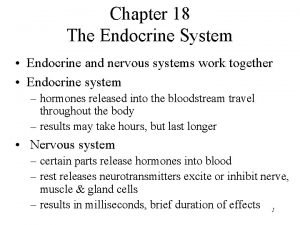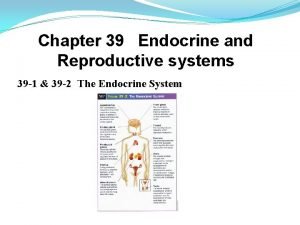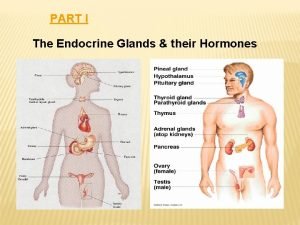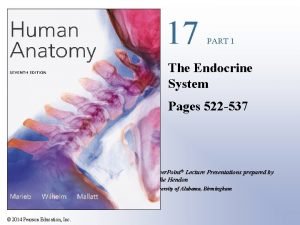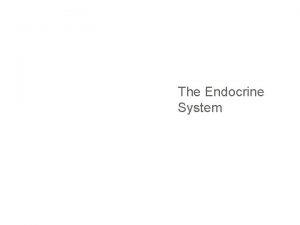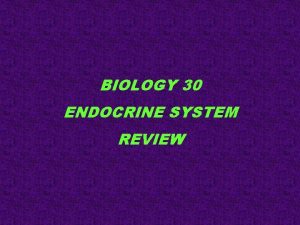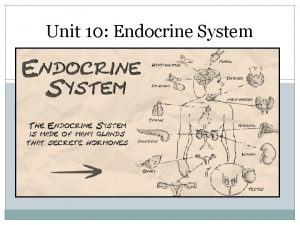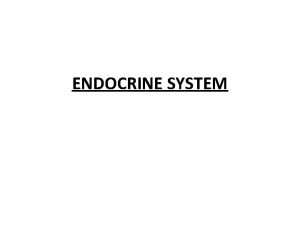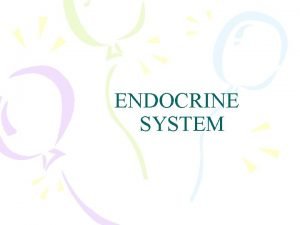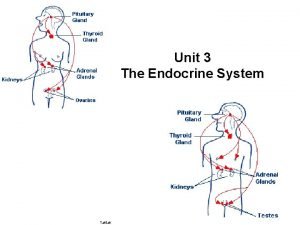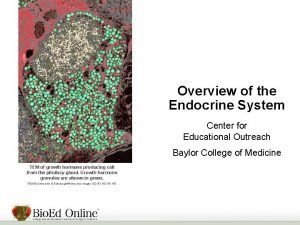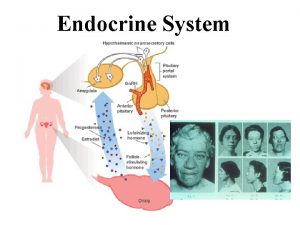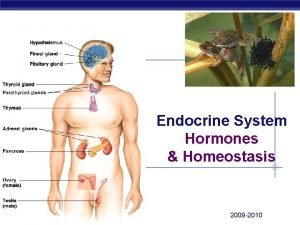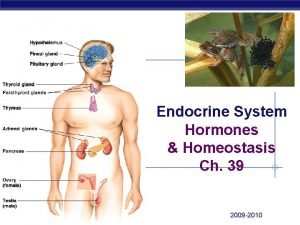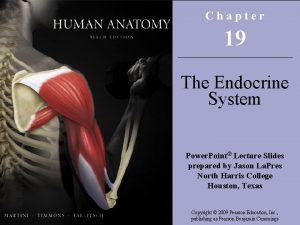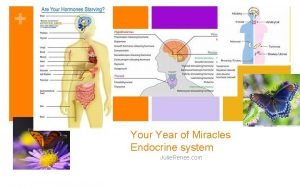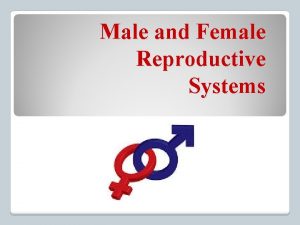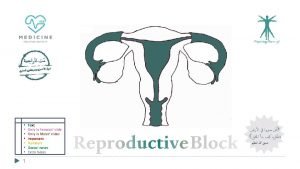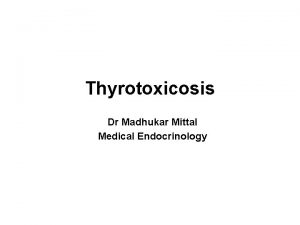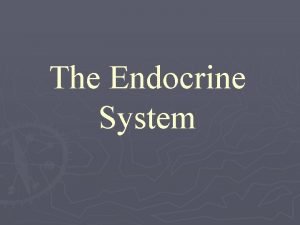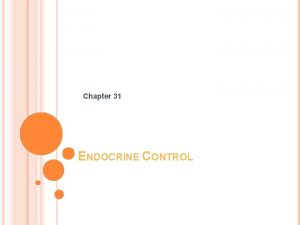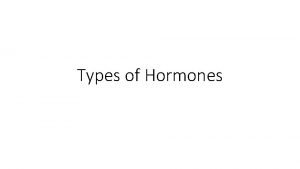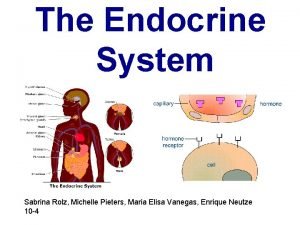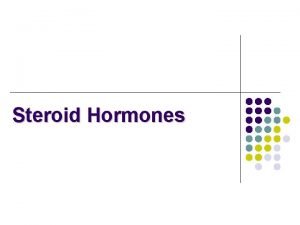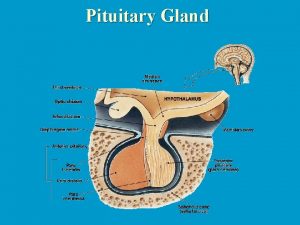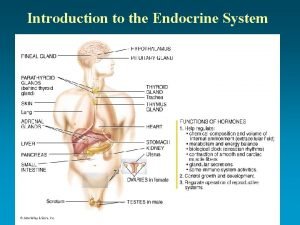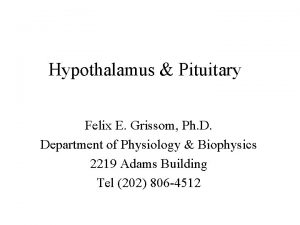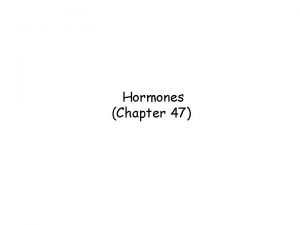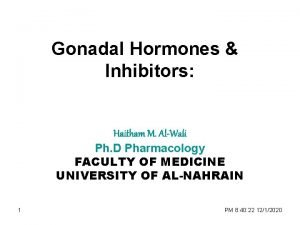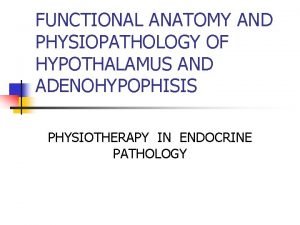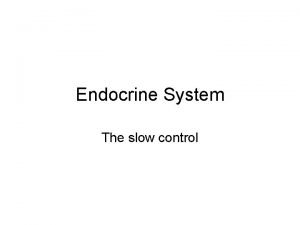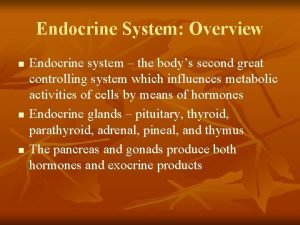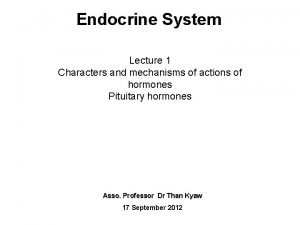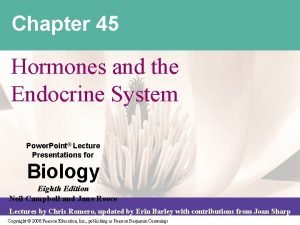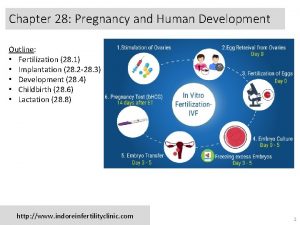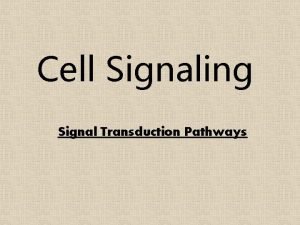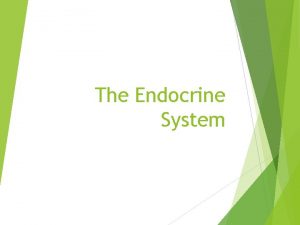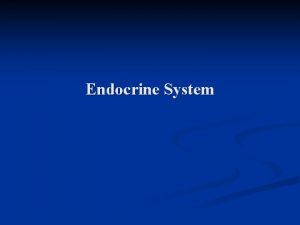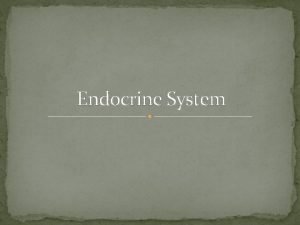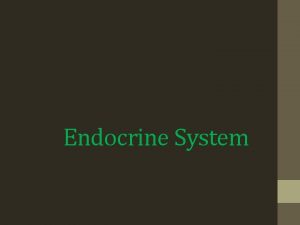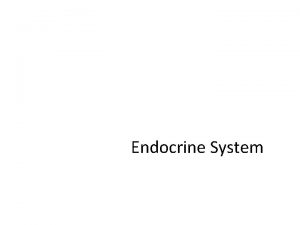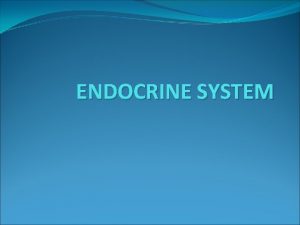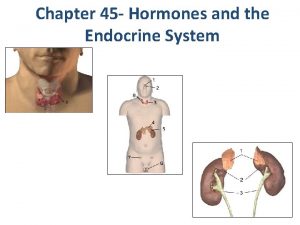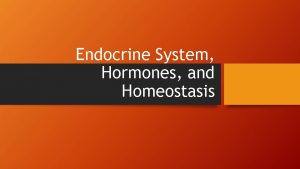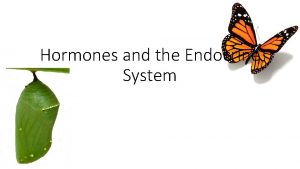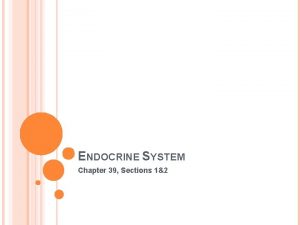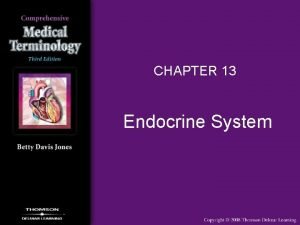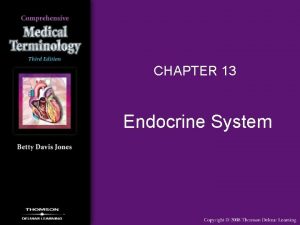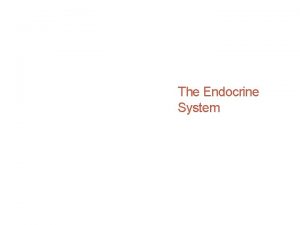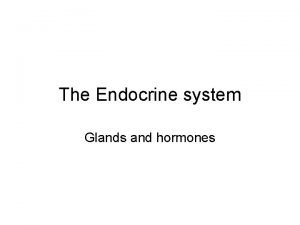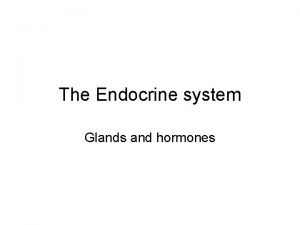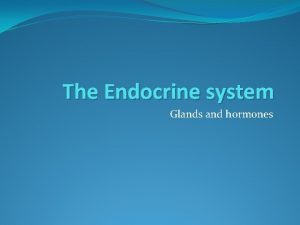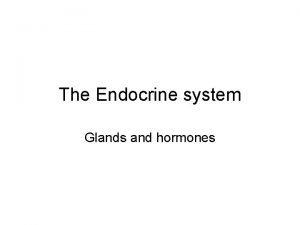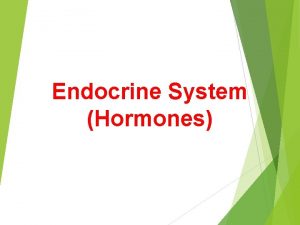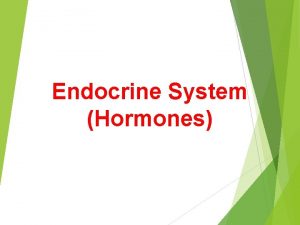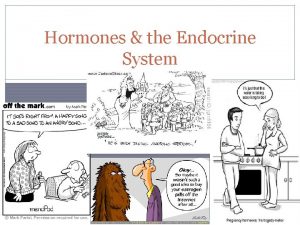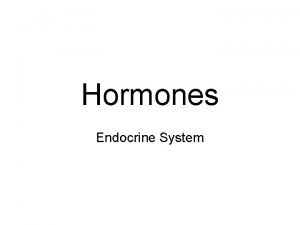Chapter 45 Hormones and the Endocrine System Power














































































- Slides: 78

Chapter 45 Hormones and the Endocrine System Power. Point® Lecture Presentations for Biology Eighth Edition Neil Campbell and Jane Reece Lectures by Chris Romero, updated by Erin Barley with contributions from Joan Sharp Copyright © 2008 Pearson Education, Inc. , publishing as Pearson Benjamin Cummings

Overview: The Body’s Long-Distance Regulators • Animal hormones are chemical signals that are secreted into the circulatory system and communicate regulatory messages within the body. • Hormones reach all parts of the body, but only target cells are equipped to respond. • Insect metamorphosis is regulated by hormones. Copyright © 2008 Pearson Education, Inc. , publishing as Pearson Benjamin Cummings

• Two systems coordinate communication throughout the body: the endocrine system and the nervous system. • The endocrine system secretes hormones that coordinate slower but longer-acting responses including reproduction, development, energy metabolism, growth, and behavior. • The nervous system conveys high-speed electrical signals along specialized cells called neurons; these signals regulate other cells. Copyright © 2008 Pearson Education, Inc. , publishing as Pearson Benjamin Cummings

What role do hormones play in transforming a caterpillar into a butterfly?

Hormones and other signaling molecules bind to target receptors, triggering specific response pathways • Chemical signals bind to receptor proteins on target cells. • Only target cells respond to the signal. Copyright © 2008 Pearson Education, Inc. , publishing as Pearson Benjamin Cummings

Types of Secreted Signaling Molecules • Secreted chemical signals include – Hormones – Local regulators – Neurotransmitters – Neurohormones – Pheromones Copyright © 2008 Pearson Education, Inc. , publishing as Pearson Benjamin Cummings

Hormones • Endocrine signals (hormones) are secreted into extracellular fluids and travel via the bloodstream. • Endocrine glands are ductless and secrete hormones directly into surrounding fluid. • Hormones mediate responses to environmental stimuli and regulate growth, development, and reproduction. • Exocrine glands have ducts and secrete substances onto body surfaces or into body cavities (for example, tear ducts). Copyright © 2008 Pearson Education, Inc. , publishing as Pearson Benjamin Cummings

Intercellular communication by secreted molecules Blood vessel (a) Endocrine Response signaling Response (b) Paracrine signaling Response (c) Autocrine signaling Synapse Neuron Response (d) Synaptic signaling Neurosecretory cell Blood vessel (e) Neuroendocrine Response signaling

Local Regulators = Short Distance Chemical Signals • Local regulators are chemical signals that travel over short distances by diffusion. • Local regulators help regulate blood pressure, nervous system function, and reproduction. • Local regulators are divided into two types: – Paracrine signals act on cells near the secreting cell. – Autocrine signals act on the secreting cell itself. Copyright © 2008 Pearson Education, Inc. , publishing as Pearson Benjamin Cummings

Intercellular communication by secreted molecules Blood vessel Response (a) Endocrine signaling Response (b) Paracrine signaling Response (c) Autocrine signaling

Neurotransmitters and Neurohormones • Neurons (nerve cells) contact target cells at synapses. • At synapses, neurons often secrete chemical signals called neurotransmitters that diffuse a short distance to bind to receptors on the target cell. Neurotransmitters play a role in sensation, memory, cognition, and movement. • Neurohormones are a class of hormones that originate from neurons in the brain and diffuse through the bloodstream. Copyright © 2008 Pearson Education, Inc. , publishing as Pearson Benjamin Cummings

Intercellular communication by secreted molecules Synapse Neuron Response (d) Synaptic signaling - neurotransmitters Neurosecretory cell Blood vessel (e) Neuroendocrine signaling Response

Pheromones • Pheromones are chemical signals that are released from the body and used to communicate with other individuals in the species. • Pheromones mark trails to food sources, warn of predators, and attract potential mates. Copyright © 2008 Pearson Education, Inc. , publishing as Pearson Benjamin Cummings

Chemical Classes of Hormones • Three major classes of molecules function as hormones in vertebrates: – Polypeptides (proteins and peptides) – Amines derived from amino acids – Steroid hormones Polypeptides and amines are water-soluble. Steroids are lipid-soluble. Copyright © 2008 Pearson Education, Inc. , publishing as Pearson Benjamin Cummings

• Lipid-soluble hormones (steroid hormones) pass easily through cell membranes. • Water-soluble hormones (polypeptides and amines) do not pass through the cell membrane. • The solubility of a hormone correlates with the location of receptors inside or on the surface of target cells. Copyright © 2008 Pearson Education, Inc. , publishing as Pearson Benjamin Cummings

Hormones differ in form and solubility Water-soluble Lipid-soluble 0. 8 nm Polypeptide: Insulin Steroid: Cortisol Amine: Epinephrine Amine: Thyroxine

Cellular Response Pathways • Water and lipid soluble hormones differ in their paths through a body. • Water-soluble hormones are secreted by exocytosis, travel freely in the bloodstream, and bind to cell-surface receptors. • Lipid-soluble hormones diffuse across cell membranes, travel in the bloodstream bound to transport proteins, and diffuse through the plasma membrane of target cells. Copyright © 2008 Pearson Education, Inc. , publishing as Pearson Benjamin Cummings

signal transduction pathway • Signaling by any of these hormones involves three key events: – Reception – Signal transduction – Response • Binding of a hormone to its receptor initiates a signal transduction pathway leading to responses in the cytoplasm, enzyme activation, or a change in gene expression. Copyright © 2008 Pearson Education, Inc. , publishing as Pearson Benjamin Cummings

Receptor location varies with hormone type Fat-soluble hormone Watersoluble hormone Signal receptor Transport protein TARGET CELL (a) Signal receptor NUCLEUS (b)

Receptor location varies with hormone type Fat-soluble hormone Watersoluble hormone Transport protein Signal receptor TARGET CELL Cytoplasmic response (a) OR Gene regulation NUCLEUS Signal receptor Cytoplasmic response (b) Gene regulation

Pathway for Water-Soluble Hormones • The hormone epinephrine has multiple effects in mediating the body’s response to short-term stress. • Epinephrine binds to receptors on the plasma membrane of liver cells. • This triggers the release of messenger molecules that activate enzymes and result in the release of glucose into the bloodstream. Copyright © 2008 Pearson Education, Inc. , publishing as Pearson Benjamin Cummings

Epinephrine Adenylyl cyclase G protein-coupled receptor GTP Cell-surface hormone receptors trigger signal transduction Inhibition of glycogen synthesis Promotion of glycogen breakdown ATP c. AMP Protein kinase A Second messenger

Pathway for Lipid-Soluble Hormones • The response to a lipid-soluble hormone is usually a change in gene expression. • Steroids, thyroid hormones, and the hormonal form of vitamin D enter target cells and bind to protein receptors in the cytoplasm or nucleus. • Protein-receptor complexes then act as transcription factors in the nucleus, regulating transcription of specific genes. Copyright © 2008 Pearson Education, Inc. , publishing as Pearson Benjamin Cummings

Steroid hormone receptors are inside the cell and directly regulate gene expression Hormone (estradiol) Estradiol (estrogen) receptor Plasma membrane Hormone-receptor complex DNA Vitellogenin m. RNA for vitellogenin

Multiple Effects of Hormones • The same hormone may have different effects on target cells that have – Different receptors for the hormone – Different signal transduction pathways – Different proteins for carrying out the response. • A hormone can also have different effects in different species. Copyright © 2008 Pearson Education, Inc. , publishing as Pearson Benjamin Cummings

One hormone, different effects Same receptors but different intracellular proteins Different receptors Epinephrine receptor Glycogen deposits Glycogen breaks down and glucose is released. (a) Liver cell Vessel dilates. (b) Skeletal muscle blood vessel Vessel constricts. (c) Intestinal blood vessel

Specialized role of a hormone in frog metamorphosis (a) (b)

Signaling by Local Regulators • In paracrine signaling, nonhormonal chemical signals called local regulators elicit responses in nearby target cells. • Types of local regulators: – Cytokines and growth factors – Nitric oxide (NO) – Prostaglandins - help regulate aggregation of platelets, an early step in formation of blood clots. Copyright © 2008 Pearson Education, Inc. , publishing as Pearson Benjamin Cummings

Major endocrine glands: Hypothalamus Pineal gland Pituitary gland Thyroid gland Parathyroid glands Organs containing endocrine cells: Thymus Heart Adrenal glands Testes Liver Stomach Pancreas Kidney Small intestine Ovaries

Simple Hormone Pathways • Negative feedback and antagonistic hormone pairs are common features of the endocrine system. • Hormones are assembled into regulatory pathways. • Hormones are released from an endocrine cell, travel through the bloodstream, and interact with the receptor or a target cell to cause a physiological response. Copyright © 2008 Pearson Education, Inc. , publishing as Pearson Benjamin Cummings

A simple endocrine pathway Pathway Negative feedback – Example Stimulus Low p. H in duodenum S cells of duodenum secrete secretin ( ) Endocrine cell Blood vessel Target cells Response Pancreas Bicarbonate release

Insulin and Glucagon: Control of Blood Glucose • A negative feedback loop inhibits a response by reducing the initial stimulus. • Negative feedback reverses a trend to regulate many hormonal pathways involved in homeostasis. • Insulin and glucagon are antagonistic hormones that help maintain glucose homeostasis. • The pancreas has endocrine cells called islets of Langerhans with alpha cells that produce glucagon and beta cells that produce insulin. Copyright © 2008 Pearson Education, Inc. , publishing as Pearson Benjamin Cummings

Body cells take up more glucose. Insulin Lowers Blood Glucose Levels Insulin Beta cells of pancreas release insulin into the blood. Liver takes up glucose and stores it as glycogen. STIMULUS: Blood glucose level rises. Blood glucose level declines. Homeostasis: Blood glucose level (about 90 mg/100 m. L)

Glucagon Raises Blood Glucose Levels Homeostasis: Blood glucose level (about 90 mg/100 m. L) STIMULUS: Blood glucose level falls. Blood glucose level rises. Alpha cells of pancreas release glucagon. Liver breaks down glycogen and releases glucose. Glucagon

Maintenance of glucose homeostasis by insulin and glucagon Body cells take up more glucose. Insulin Beta cells of pancreas release insulin into the blood. Liver takes up glucose and stores it as glycogen. STIMULUS: Blood glucose level rises. Blood glucose level declines. Homeostasis: Blood glucose level (about 90 mg/100 m. L) STIMULUS: Blood glucose level falls. Blood glucose level rises. Alpha cells of pancreas release glucagon. Liver breaks down glycogen and releases glucose. Glucagon

Target Tissues for Insulin and Glucagon • Insulin reduces blood glucose levels by – Promoting the cellular uptake of glucose – Slowing glycogen breakdown in the liver – Promoting fat storage. • Glucagon increases blood glucose levels by – Stimulating conversion of glycogen to glucose in the liver – Stimulating breakdown of fat and protein into glucose. Copyright © 2008 Pearson Education, Inc. , publishing as Pearson Benjamin Cummings

Diabetes Mellitus • Diabetes mellitus is an endocrine disorder caused by a deficiency of insulin or a decreased response to insulin in target tissues. • It is marked by elevated blood glucose levels. • Type I diabetes mellitus (insulin-dependent) is an autoimmune disorder in which the immune system destroys pancreatic beta cells. • Type II diabetes mellitus (non-insulin-dependent) involves insulin deficiency or reduced response of target cells due to change in insulin receptors. Copyright © 2008 Pearson Education, Inc. , publishing as Pearson Benjamin Cummings

The endocrine and nervous systems act individually and together in regulating animal physiology • Signals from the nervous system initiate and regulate endocrine signals. Copyright © 2008 Pearson Education, Inc. , publishing as Pearson Benjamin Cummings

Coordination of Endocrine and Nervous Systems in Invertebrates • In insects, molting and development are controlled by a combination of hormones: – A brain hormone stimulates release of ecdysone from the prothoracic glands – Juvenile hormone promotes retention of larval characteristics – Ecdysone promotes molting (in the presence of juvenile hormone) and development (in the absence of juvenile hormone) of adult characteristics Copyright © 2008 Pearson Education, Inc. , publishing as Pearson Benjamin Cummings

Hormonal regulation of insect development Brain Neurosecretory cells Corpus cardiacum PTTH Corpus allatum Low JH Prothoracic gland Ecdysone EARLY LARVA Juvenile hormone (JH) LATER LARVA PUPA ADULT

Coordination of Endocrine and Nervous Systems in Vertebrates • The hypothalamus receives information from the nervous system and initiates responses through the endocrine system. • Attached to the hypothalamus is the pituitary gland composed of the posterior pituitary and anterior pituitary. Copyright © 2008 Pearson Education, Inc. , publishing as Pearson Benjamin Cummings

• The posterior pituitary stores and secretes hormones that are made in the hypothalamus • The anterior pituitary makes and releases hormones under regulation of the hypothalamus Copyright © 2008 Pearson Education, Inc. , publishing as Pearson Benjamin Cummings

Cerebrum Pineal gland Thalamus Cerebellum Pituitary gland Hypothalamus = brain Spinal cord Endocrine glands in the human brain Hypothalamus Posterior pituitary Anterior pituitary



Posterior Pituitary Hormones • Oxytocin induces uterine contractions and the release of milk • Suckling sends a message to the hypothalamus via the nervous system to release oxytocin, which further stimulates the milk glands • This is an example of positive feedback, where the stimulus leads to an even greater response • Antidiuretic hormone (ADH) enhances water reabsorption in the kidneys Copyright © 2008 Pearson Education, Inc. , publishing as Pearson Benjamin Cummings

A simple neurohormone pathway Pathway Example Stimulus Suckling + Sensory neuron Positive feedback Hypothalamus/ posterior pituitary Neurosecretory cell Blood vessel Target cells Response Posterior pituitary secretes oxytocin ( ) Smooth muscle in breasts Milk release

Anterior Pituitary Hormones • Hormone production in the anterior pituitary is controlled by releasing and inhibiting hormones from the hypothalamus • For example, the production of thyrotropin releasing hormone (TRH) in the hypothalamus stimulates secretion of the thyroid stimulating hormone (TSH) from the anterior pituitary Copyright © 2008 Pearson Education, Inc. , publishing as Pearson Benjamin Cummings

Production and release of anterior pituitary hormones Tropic effects only: FSH LH TSH ACTH Neurosecretory cells of the hypothalamus Nontropic effects only: Prolactin MSH Nontropic and tropic effects: GH Hypothalamic releasing and inhibiting hormones Portal vessels Endocrine cells of the anterior pituitary Posterior pituitary Pituitary hormones HORMONE TARGET FSH and LH Testes or ovaries TSH Thyroid ACTH Adrenal cortex Prolactin Mammary glands MSH Melanocytes GH Liver, bones, other tissues

Hormone Cascade Pathways • A hormone can stimulate the release of a series of other hormones, the last of which activates a nonendocrine target cell; this is called a hormone cascade pathway. • The release of thyroid hormone results from a hormone cascade pathway involving the hypothalamus, anterior pituitary, and thyroid gland. • Hormone cascade pathways are usually regulated by negative feedback. Copyright © 2008 Pearson Education, Inc. , publishing as Pearson Benjamin Cummings

Example Pathway A hormone Stimulus casade pathway Cold Sensory neuron Hypothalamus secretes thyrotropin-releasing hormone (TRH ) Neurosecretory cell Blood vessel

A hormone casade pathway Example Pathway + Stimulus Cold Sensory neuron Neurosecretory cell Hypothalamus secretes thyrotropin-releasing hormone (TRH ) Blood vessel Anterior pituitary secretes thyroid-stimulating hormone (TSH or thyrotropin )

Pathway A hormone casade pathway Example Stimulus Cold Sensory neuron – Hypothalamus secretes thyrotropin-releasing hormone (TRH ) Neurosecretory cell Blood vessel – Negative feedback Anterior pituitary secretes thyroid-stimulating hormone (TSH or thyrotropin ) Thyroid gland secretes thyroid hormone (T 3 and T 4 ) Target cells Response Body tissues Increased cellular metabolism

Tropic Hormones • A tropic hormone regulates the function of endocrine cells or glands. • The four strictly tropic hormones are: – Thyroid-stimulating hormone (TSH) – Follicle-stimulating hormone (FSH) – Luteinizing hormone (LH) – Adrenocorticotropic hormone (ACTH) Copyright © 2008 Pearson Education, Inc. , publishing as Pearson Benjamin Cummings

Nontropic Hormones - target nonendocrine tissues. • Nontropic hormones produced by the anterior pituitary are: – Prolactin (PRL) – Melanocyte-stimulating hormone (MSH) • Prolactin stimulates lactation in mammals but has diverse effects in different vertebrates. • MSH influences skin pigmentation in some vertebrates and fat metabolism in mammals. Copyright © 2008 Pearson Education, Inc. , publishing as Pearson Benjamin Cummings

Growth Hormone • Growth hormone (GH) is secreted by the anterior pituitary gland has tropic and nontropic actions. • It promotes growth directly and has diverse metabolic effects. • It stimulates production of growth factors. • An excess of GH can cause gigantism, while a lack of GH can cause dwarfism. Copyright © 2008 Pearson Education, Inc. , publishing as Pearson Benjamin Cummings

Endocrine glands respond to diverse stimuli in regulating metabolism, homeostasis, development, and behavior • Endocrine signaling regulates metabolism, homeostasis, development, and behavior. Copyright © 2008 Pearson Education, Inc. , publishing as Pearson Benjamin Cummings

Thyroid Hormone: Control of Metabolism and Development • The thyroid gland consists of two lobes on the ventral surface of the trachea. • It produces two iodine-containing hormones: triiodothyronine (T 3) and thyroxine (T 4). • Proper thyroid function requires dietary iodine for thyroid hormone production. Copyright © 2008 Pearson Education, Inc. , publishing as Pearson Benjamin Cummings

• Thyroid hormones stimulate metabolism and influence development and maturation. • Hyperthyroidism, excessive secretion of thyroid hormones, causes high body temperature, weight loss, irritability, and high blood pressure. • Graves’ disease is a form of hyperthyroidism in humans. • Hypothyroidism, low secretion of thyroid hormones, causes weight gain, lethargy, and intolerance to cold. Copyright © 2008 Pearson Education, Inc. , publishing as Pearson Benjamin Cummings

Parathyroid Hormone and Vitamin D: Control of Blood Calcium • Two antagonistic hormones regulate the homeostasis of calcium (Ca 2+) in the blood of mammals – Parathyroid hormone (PTH) is released by the parathyroid glands – Calcitonin is released by the thyroid gland Copyright © 2008 Pearson Education, Inc. , publishing as Pearson Benjamin Cummings

Antagonistic Hormone Pairs control blood calcium levels Active vitamin D Increases Ca 2+ uptake in intestines Stimulates Ca 2+ uptake in kidneys PTH Stimulates Ca 2+ release from bones Parathyroid gland (behind thyroid) STIMULUS: Falling blood Ca 2+ level Ca 2+ Blood level rises. Homeostasis: Blood Ca 2+ level (about 10 mg/100 m. L)

• PTH increases the level of blood Ca 2+ – It releases Ca 2+ from bone and stimulates reabsorption of Ca 2+ in the kidneys – It also has an indirect effect, stimulating the kidneys to activate vitamin D, which promotes intestinal uptake of Ca 2+ from food • Calcitonin decreases the level of blood Ca 2+ – It stimulates Ca 2+ deposition in bones and secretion by kidneys Copyright © 2008 Pearson Education, Inc. , publishing as Pearson Benjamin Cummings

Adrenal Hormones: Response to Stress • The adrenal glands are adjacent to the kidneys. • Each adrenal gland actually consists of two glands: the adrenal medulla (inner portion) and adrenal cortex (outer portion). Copyright © 2008 Pearson Education, Inc. , publishing as Pearson Benjamin Cummings

Catecholamines from the Adrenal Medulla • The adrenal medulla secretes epinephrine (adrenaline) and norepinephrine (noradrenaline). • These hormones are members of a class of compounds called catecholamines. • They are secreted in response to stressactivated impulses from the nervous system. • They mediate various fight-or-flight responses. Copyright © 2008 Pearson Education, Inc. , publishing as Pearson Benjamin Cummings

• Epinephrine and norepinephrine – Trigger the release of glucose and fatty acids into the blood – Increase oxygen delivery to body cells – Direct blood toward heart, brain, and skeletal muscles, and away from skin, digestive system, and kidneys. • The release of epinephrine and norepinephrine occurs in response to nerve signals from the hypothalamus. Copyright © 2008 Pearson Education, Inc. , publishing as Pearson Benjamin Cummings

Summary: Stress and the Adrenal Gland Stress Spinal cord Nerve signals Hypothalamus Releasing hormone Nerve cell Anterior pituitary Blood vessel ACTH Adrenal medulla Adrenal cortex Adrenal gland Kidney (a) Short-term stress response Effects of epinephrine and norepinephrine: 1. Glycogen broken down to glucose; increased blood glucose 2. Increased blood pressure 3. Increased breathing rate 4. Increased metabolic rate 5. Change in blood flow patterns, leading to increased alertness and decreased digestive, excretory, and reproductive system activity (b) Long-term stress response Effects of mineralocorticoids: Effects of glucocorticoids: 1. Retention of sodium 1. Proteins and fats broken down ions and water by and converted to glucose, leading kidneys to increased blood glucose 2. Increased blood volume and blood pressure 2. Possible suppression of immune system

Stress and the Adrenal Gland Stress Spinal cord Nerve signals Releasing hormone Nerve cell Hypothalamus Anterior pituitary Blood vessel ACTH Adrenal medulla Adrenal cortex Adrenal gland Kidney

Short-term Stress and the Adrenal Gland Adrenal medulla Adrenal gland Kidney (a) Short-term stress response Effects of epinephrine and norepinephrine: 1. Glycogen broken down to glucose; increased blood glucose 2. Increased blood pressure 3. Increased breathing rate 4. Increased metabolic rate 5. Change in blood flow patterns, leading to increased alertness and decreased digestive, excretory, and reproductive system activity

Steroid Hormones from the Adrenal Cortex • The adrenal cortex releases a family of steroids called corticosteroids in response to stress. • These hormones are triggered by a hormone cascade pathway via the hypothalamus and anterior pituitary. • Humans produce two types of corticosteroids: glucocorticoids and mineralocorticoids. Copyright © 2008 Pearson Education, Inc. , publishing as Pearson Benjamin Cummings

Long-term Stress and the adrenal gland Adrenal cortex Adrenal gland Kidney (b) Long-term stress response Effects of mineralocorticoids: glucocorticoids: 1. Retention of sodium ions and water by kidneys 1. Proteins and fats broken down and converted to glucose, leading to increased blood glucose 2. Increased blood volume and blood pressure 2. Possible suppression of immune system

• Glucocorticoids, such as cortisol, influence glucose metabolism and the immune system. • Mineralocorticoids, such as aldosterone, affect salt and water balance. • The adrenal cortex also produces small amounts of steroid hormones that function as sex hormones. Copyright © 2008 Pearson Education, Inc. , publishing as Pearson Benjamin Cummings

Gonadal Sex Hormones • The gonads = testes and ovaries, produce most of the sex hormones: androgens, estrogens, and progestins. • All three sex hormones are found in both males and females, but in different amounts. Copyright © 2008 Pearson Education, Inc. , publishing as Pearson Benjamin Cummings

• The testes primarily synthesize androgens, mainly testosterone, which stimulate development and maintenance of the male reproductive system and male secondary sex characteristics. • Testosterone causes an increase in muscle and bone mass and is often taken as a supplement to cause muscle growth, which carries health risks. Copyright © 2008 Pearson Education, Inc. , publishing as Pearson Benjamin Cummings

• Estrogens, made in the ovary, most importantly estradiol, are responsible for maintenance of the female reproductive system and the development of female secondary sex characteristics. • In mammals, progestins, which include progesterone, are primarily involved in preparing and maintaining the uterus. • Synthesis of the sex hormones is controlled by FSH and LH from the anterior pituitary. Copyright © 2008 Pearson Education, Inc. , publishing as Pearson Benjamin Cummings

Pineal Gland - Melatonin and Biorhythms • The pineal gland, located in the brain, secretes melatonin. • Light/dark cycles control release of melatonin. • Primary functions of melatonin appear to relate to biological rhythms associated with reproduction. Copyright © 2008 Pearson Education, Inc. , publishing as Pearson Benjamin Cummings

Signal Transduction Pathway Negative feedback – Stimulus Example Low blood glucose Endocrine cell Pancreas alpha cells secretes glucagon Blood vessel Target cells Response Liver Glycogen breakdown, glucose release into blood

You should now be able to: 1. Distinguish between the following pairs of terms: hormones and local regulators, paracrine and autocrine signals. 2. Describe the evidence that steroid hormones have intracellular receptors, while watersoluble hormones have cell-surface receptors. 3. Explain how the antagonistic hormones insulin and glucagon regulate carbohydrate metabolism. 4. Distinguish between type 1 and type 2 diabetes. Copyright © 2008 Pearson Education, Inc. , publishing as Pearson Benjamin Cummings

5. Explain how the hypothalamus and the pituitary glands interact and how they coordinate the endocrine system. 6. Explain the role of tropic hormones in coordinating endocrine signaling throughout the body. 7. List and describe the functions of hormones released by the following: anterior and posterior pituitary lobes, thyroid glands, parathyroid glands, adrenal medulla, adrenal cortex, gonads, pineal gland. Copyright © 2008 Pearson Education, Inc. , publishing as Pearson Benjamin Cummings
 Calcitonin and pth are antagonistic hormones
Calcitonin and pth are antagonistic hormones Nontropic hormones
Nontropic hormones Endocrine system and reproductive system
Endocrine system and reproductive system Endocrine system
Endocrine system Endocrine system and nervous system
Endocrine system and nervous system Lympathic
Lympathic Mechanism of action of hormones
Mechanism of action of hormones Chapter 16
Chapter 16 Chapter 7:13 endocrine system
Chapter 7:13 endocrine system Chapter 11 endocrine system
Chapter 11 endocrine system Chapter 23 the endocrine system
Chapter 23 the endocrine system Unit 6 human development lesson 1 pregnancy
Unit 6 human development lesson 1 pregnancy What are the lipid soluble hormones
What are the lipid soluble hormones Differences between nervous system and endocrine
Differences between nervous system and endocrine Comparison of endocrine and nervous system
Comparison of endocrine and nervous system Endocrine and nervous system comparison
Endocrine and nervous system comparison Chapter 46 digestive and endocrine disorders
Chapter 46 digestive and endocrine disorders Chapter 39 endocrine and reproductive systems
Chapter 39 endocrine and reproductive systems Chapter 29 endocrine and metabolic disorders
Chapter 29 endocrine and metabolic disorders Chapter 19 endocrine and hematologic emergencies
Chapter 19 endocrine and hematologic emergencies Power triangle formula
Power triangle formula Adenohypophysis
Adenohypophysis Gonads glands
Gonads glands Endocrine system fact
Endocrine system fact Rat external anatomy
Rat external anatomy Metabolic action of growth hormone
Metabolic action of growth hormone Stimulus endocrine system
Stimulus endocrine system Humoral stimulus
Humoral stimulus Biology 30 endocrine system
Biology 30 endocrine system Chromaffin cells
Chromaffin cells Endocrine system analogy
Endocrine system analogy The endocrine system consists of
The endocrine system consists of Endocrine system abbreviations
Endocrine system abbreviations T3.taktak
T3.taktak Endocrine system
Endocrine system Classification of hormone
Classification of hormone Baylor
Baylor Glands of the endocrine system
Glands of the endocrine system Endocrine system
Endocrine system Endocrine system regents questions
Endocrine system regents questions Endocrine system regents questions
Endocrine system regents questions Pearson endocrine system
Pearson endocrine system Your year of miracles
Your year of miracles Power angle curve in power system stability
Power angle curve in power system stability Bioflix activity homeostasis low blood glucose
Bioflix activity homeostasis low blood glucose Male and female hormones
Male and female hormones Male and female hormones
Male and female hormones Bioflix activity homeostasis high blood glucose
Bioflix activity homeostasis high blood glucose Respond to
Respond to Plant hormones and responses
Plant hormones and responses Madhukar mittal
Madhukar mittal Surfaces of thyroid gland
Surfaces of thyroid gland Bryant et al
Bryant et al Terminologi sistem endokrin
Terminologi sistem endokrin Major endocrine glands male and female
Major endocrine glands male and female Difference between endocrine and exocrine glands
Difference between endocrine and exocrine glands Whats the difference between endocrine and exocrine glands
Whats the difference between endocrine and exocrine glands Steroid hormones
Steroid hormones Hypotalanus
Hypotalanus Steroid hormones classification
Steroid hormones classification Cytokinin function
Cytokinin function Amiformes
Amiformes Hormones definition psychology
Hormones definition psychology Transportation of hormones
Transportation of hormones Prolactin target cells
Prolactin target cells Hypothalamus hormones
Hypothalamus hormones Lipid soluble hormones examples
Lipid soluble hormones examples Lipid soluble hormones examples
Lipid soluble hormones examples Gonadal hormones
Gonadal hormones Hypothalamic hormones
Hypothalamic hormones Nontropic hormones
Nontropic hormones Amino acid-based hormones
Amino acid-based hormones Examples of amine hormones
Examples of amine hormones Tropic hormones
Tropic hormones Tropic vs nontropic hormones
Tropic vs nontropic hormones Four classes of hormones
Four classes of hormones Nontropic hormones
Nontropic hormones Hormones during pregnancy
Hormones during pregnancy Autocrine hormones
Autocrine hormones












